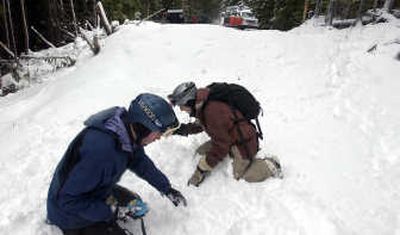Avalanche of interest

The first significant snowstorms in the high country have ushered in two simultaneous seasons of interest to skiers, boarders and snowmobilers – the winter sports season and the avalanche season.
The number of avalanche-caused deaths in the United States has been trending downward since a record 35 fatalities were recorded in 2001, according to statistics compiled by the Colorado Avalanche Center.
The decline in annual fatalities seems to indicate that increased emphasis on avalanche forecasting and awareness training is having some results, experts say.
To reach the critical audience of 20-something backcountry skiers who are the most common victims of avalanches, Montana officials resorted to putting avalanche forecasts and videos on YouTube last year. (Go to www.youtube.com and search for “AvalancheGuys.”)
Snowmobilers, powered by new high-performance machines, outpaced backcountry skiing victims to become the major factor in the spike of avalanche deaths that started in the 1990s.
Last year, 23 people died in avalanches across the United States. Montana led the statistics with six fatalities, but Idaho ranked high in the statistics.
Twelve of the nation’s fatalities last season were snowmobile riders and three out of the 12 were from Idaho.
Triggering an avalanche means that you’ve already done something wrong and avalanche gear and training can’t change that fact, said Doug Chabot, Montana Avalanche Center director for the Gallatin National Forest.
Chabot makes this and other clear points in a powerful 30-minute documentary on backcountry travel in avalanche terrain. The film was produced this year with the help of the Avalanche Center based on footage from the party involved in a 2005 tragedy near Bozeman.
“A Dozen More Turns,” by Amber Seyler focuses on the human factor that led to the death of an avalanche expert caught up in the emotional high of skiing deep backcountry powder with his group of five.
Although it’s based on a skiing accident, the factors apply to all backcountry travelers, including snowmobilers.
One man, who survived the incident only because of a heroic rescue by a military helicopter, said the group had discussed the snow conditions and dangers but essentially disregarded them as the day went on because they were “so stoked” about the great skiing in new powder snow.
For the sake of going just a little higher to get a few more turns, they exposed themselves to unstable snow that killed one of their group. The other victim suffered injuries that required the amputation of his leg.
All winter backcountry travelers should carry a shovel, probe and avalanche transceiver while recognizing and compensating for risks, Chabot says.
But the surviving victim in the documentary makes an impassioned case for playing it safe when conditions are questionable.
Lives will be saved this year, Chabot said, if winter backcountry travelers adopt these basic behaviors to reduce avalanche risks inherent in the sports.
One at a time: In Montana, more than half the people killed in avalanches would be alive today if only one skier or rider at a time was exposed on a slope.
Carry gear: If all backcountry travelers carried rescue gear and knew how to use it, the number of fatalities would be significantly reduced. There is nothing worse on a ski or snowmobile accident scene than finding someone dead from a shallow burial where a transceiver may have saved a life.
Acknowledge conditions: Learn to recognize the signs of recent avalanche activity and unstable snow conditions and avoid traveling in that terrain. Monitor avalanche forecasts.
Safety education: Avalanche training helps a snowmobile rider to make informed decisions based on real data instead of wishful thinking. Organizations frequently put on snow travel courses and seminars.